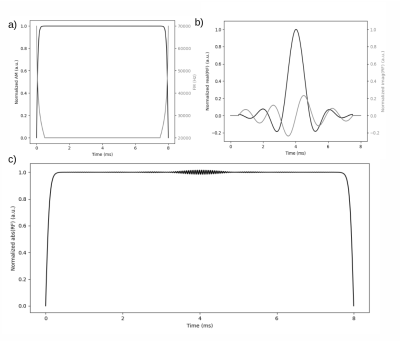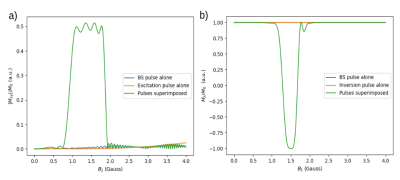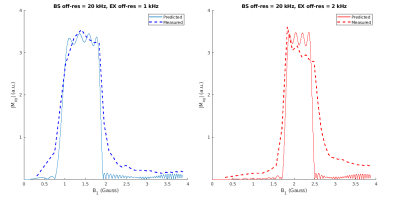3337
Bloch-Siegert |B1+|-Selective Excitation Pulses1Biomedical Engineering, Vanderbilt University, Nashville, TN, United States, 2Radiology, Case Western Reserve University, Cleveland, OH, United States
Synopsis
We present a new class of pulses which utilize the Bloch-Siegert shift to localize a |B1+| selective excitation. The summation of a far-off-resonant pulse inducing a |B1+|-dependent Bloch-Siegert shift and a frequency-selective excitation pulse excites spins depending on the strength of transmit field that they experience. The passband of the pulse can be shifted by adjusting the frequency modulation of each of the component pulses. We verify the ability of the new pulse to produce a selective excitation in simulation and on a scanner.
Introduction
In conventional MR imaging spatially selective excitation is achieved using B0 gradients, which induce spatial variation in the resonant frequencies of spins. Selective excitation is then achieved by playing out pulses containing frequencies that map to locations in space where excitation is desired (Fig 1a). However, B0 gradients have a number of drawbacks, including high cost and patient discomfort due to their loud noise and peripheral nerve stimulation. As an alternative, |B1+|-selective pulses have been proposed that selectively excite magnetization across a desired range of B1 strengths1,2,3. A notable parallel development in B0-gradient-free MR has been the recent application of the Bloch-Siegert (BS) shift as a spatial encoding method using radio frequency (RF) gradient coils4,5,6. Here we combine these concepts and introduce a new class of |B1+|-selective pulse with a novel application of the Bloch-Siegert (BS) shift. The pulses are constructed by summing a Bloch-Siegert pulse, which establishes a frequency gradient across B1's, and a conventional frequency selective excitation pulse shape that excites the desired B1 range.Methods
Pulse Design: Irradiation of nuclei with a sufficiently off-resonant RF pulse induces a shift in the resonant frequency $$\omega_{BS} = \frac{(\gamma B_1)^2}{2 \Delta\omega_{RF}}$$ where $$$\Delta\omega_{RF}$$$ denotes the off-resonance of the pulse.To utilize this relationship for |B1+|-selective excitation, we design a far-off-resonant RF pulse to induce a BS shift, then add it to a frequency selective pulse which maps by the quadratic BS shift to a range of |B1+| of interest, illustrated in Figure 1b. For our BS pulse we use an AM/FM modulated RF pulse with amplitude and frequency sweeps intended to maximize resonant frequency shift while minimizing in-band excitation, similar in form to other optimized BS pulses7. An example pulse with a sweep to 20 kHz off resonance is shown in Figure 2a. A wide degree of latitude is permitted in the design of the second excitation pulse. For proof of concept, we use SLR pulses designed with a filter8 to excite a sloped profile compensating for the rise in |B1+| across the passband, an effect that occurs when both pulses are played from the same B1 gradient coil. The resulting compensated profile is approximately flat across |B1+|. An excitation pulse designed with this filter is shown in Figure 2b. Figure 2c shows the |B1+|-selective pulse resulting from the summation of the swept BS pulse of Figure 2a with a version of the excitation pulse of Figure 2b modulated to 1 kHz.Experiments: Two pulses were designed for evaluation in simulation. The first was a 8 ms pulse with a time-bandwidth 2, 30° custom-profile SLR small-tip pulse centered at 1 kHz superimposed on a swept BS pulse with an offset frequency of 20 kHz. The second was an 8 ms pulse with a time-bandwidth 4, 180° conventional SLR inversion pulse also centered at 1 kHz and superimposed on an identical BS pulse. Both superimposed pulses as well as each of their component subpulses were simulated over a range of 0 to 4 Gauss. The excitation |B1+|-selective pulse was also implemented in a 3D GRE sequence (TE/TR 5/50 ms) on a 31 cm 4.7T Varian spectrometer (Varian Inc., Palo Alto, CA) with a homogeneous Litz volume coil. A mineral oil phantom was used. The system was used to acquire images across a range of |B1+| values by adjusting the scanner's transmit gain in successive acquisitions. B0 maps were collected, and the signal for each |B1+| was calculated from voxels for each acquisition with off-resonance within ±5 Hz to obtain on-resonance measurements of the profile. The measurement was repeated with the small tip pulse's frequency offset increased to 2 kHz, in order to observe a shift in the profile.
Results
Figures 3a and 3b show the transverse and longitudinal magnetization excited by the two simulated pulses and each of their component subpulses. In both cases the excitation from either subpulse alone is minimal, while the superimposed BS and frequency-selective pulse creates a large excitation or inversion centered at the anticipated |B1+|. Figure 4 shows the measured profiles for the 1 kHz and 2 kHz modulated small-tip pulses. For both pulses these profiles are in agreement with simulation and demonstrate that the passband of the |B1+|-selective pulse can indeed be shifted by altering the frequency modulation.Discussion and Conclusion
We introduced a new class of |B1+|-selective pulses utilizing the Bloch-Siegert shift to localize excitation across a desired range of transmit field strengths. This novel approach is flexible and can be modified to produce selective small-tip excitations, inversions, or other types of nutations depending on the type of excitation pulse chosen. In this work, it was assumed that both the BS and the frequency-selective excitation pulse were played from the same B1-gradient coil, which requires the frequency-selective excitation to compensate the B1 ramp across the slice. Alternatively, the BS pulse could be played through a gradient coil, and the frequency-selective excitation could be played through a uniform coil, in which case it would not need to compensate the B1 ramp across the passband. The pulses have numerous potential applications, including excitation localization in B0-gradient-free imaging at low fields alongside Bloch-Siegert encoding methods4,5,6, or in reduced-FOV sequences based on |B1+|-selective excitation.Acknowledgements
This work was supported by NIH grant R01 EB 030414.References
1. Hoult D. Rotating frame selective pulses, J. Magn. Reson. 1980;38:369–374.
2. Karczmar G, Lawry T, Weiner M, Matson G. Shaped pulses for slice selection in the rotating frame – a study using computer simulations, J. Magn.Reson. 1987;76:41–53
3. Grissom W, Cao Z, Does M. |B1+|-selective excitation pulse design using the Shinnar-LeRoux algorithm, J. Magn. Reson. 2014;242:189-196.
4. Kartäusch R, Fidler F, Drießle T, Kampf T, Basse-Lüsebrink T, Hoelscher U, Jakob P, Helluy X. Spatial phase encoding using a Bloch-Siegert Shift gradient. Proc. Intl. Soc. Mag. Reson. Med. 21. (2013) p 0371
5. Cao Z, Chekmenev E, Grissom W. Spatial phase encoding using a Bloch-Siegert Shift gradient. Proc. Intl. Soc. Mag. Reson. Med. 22. (2014) p0371.
6. Wan Y, Qiu M, Galiana G, Constable RT. Phase Encoding with Bloch-Siegert effect using Parallel Transmit. Proc. Intl. Soc. Mag. Reson. Med. 25 (2017) p1498.
7. Jankiewicz M, Gore J, Grissom W. Improved encoding pulses for Bloch-Siegert B1(+) mapping. J Magn Reson 2013;226:79-87.
8. Barral J, Pauly J, Nishimura D. SLR RF pulse Design for Arbitrarily-Shaped Excitation Profiles. Proc. Intl. Soc. Mag. Reson. Med. 16. (2008) p1323.
Figures



